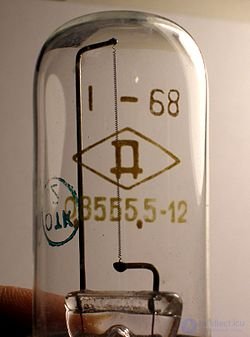Lecture



Barretter (eng. Barretter ) - an electronic device designed to stabilize the electric current
Baretter is a hydrogen-filled glass balloon, inside which is placed a thin platinum, iron or tungsten wire (filament). In fact, this is a special hydrogen-filled incandescent lamp. Such a device has a nonlinear resistance, in which in a certain range of current strength, its insignificant increase gives a significant increase in voltage at the terminals. That is, a baretter is a resistor with a positive temperature coefficient.
There are also semiconductor equivalents of hydrogen barretter, collected on semiconductor devices (transistors), or integral. [one]
The principle of operation is that as the applied voltage increases, the filament temperature increases and, consequently, its resistance. As a result, when the voltage changes on the baretter, the current strength remains almost unchanged. Thus, a barette connected in series with the load maintains a stable current in it with changes in the supply voltage. Such devices were previously used to protect expensive incandescent bulbs, filaments of kinescopes and radio tubes, in current stabilizers. Baretters limit dangerous current surges when switching on electronic equipment. With the same purpose, you can use a tungsten filament lamp if its current is in the appropriate range. Barretters, as a rule, can operate at both constant and alternating current. Baretter has noticeable thermal inertia, therefore it is able to stabilize only slow changes in current. Conventional boretters are not protected from overcurrent and are not able to set the maximum load current.
Electrotechnically barretters are the simplest bipolar parametric current stabilizers.
In the designation of a barette, the first number indicates its nominal current of barettting in amperes, the second two numbers indicate the limits of barettisation in volts.
In amateur radio schemes, halogen lamps are sometimes used as barretters due to their availability for fast prototyping, for example, to limit the battery charge current and to protect the charge circuits from current overload. In normal mode, the resistance of the lamp is small and does not cause significant damage to the efficiency of the system.
Comments
To leave a comment
Radio tubes and ion devices
Terms: Radio tubes and ion devices